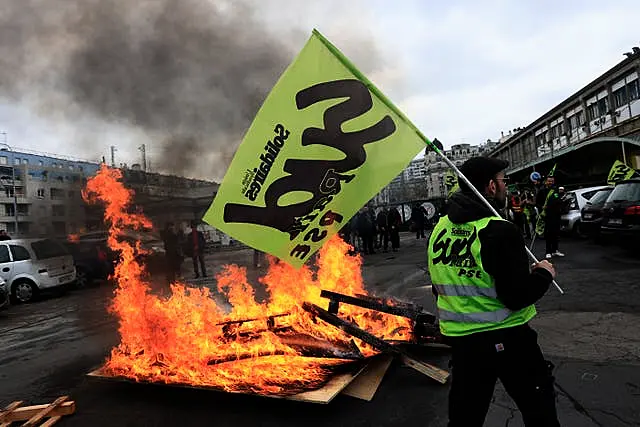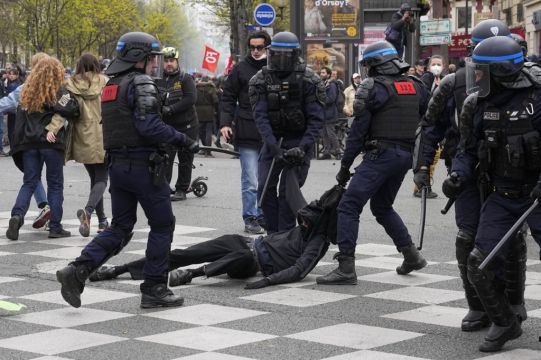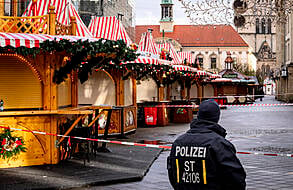Protesters have disrupted traffic around Paris’s main airport and police fired clouds of tear gas in other French cities amid the latest round of strikes and demonstrations against President Emmanuel Macron’s pension reforms.
Mr Macron’s drive to raise the national retirement age from 62 to 64 has led to a series of walkouts in recent months.
Talks between trade union leaders and Prime Minister Elisabeth Borne broke up on Wednesday without a breakthrough, setting the stage for protesters’ return to the streets.

However, the number of strikers has fallen, particularly in the transport sector, since protests began in January. About 400,000 people joined the protest in Paris on Thursday, down from 450,000 the week before, the CGT union said.
On Thursday, the Paris Metro ran almost normally, in stark contrast to previous days of action. Less than 8% of teachers were on strike, according to the Education Ministry, but the sizeable TotalEnergies oil refinery in Gonfreville-l’Orcher remained closed.
Striking workers again closed the Eiffel Tower and the unions mobilised large crowds for protests across the country. The Interior Ministry said 570,000 people took part while unions said the figure was closer to 2 million.
There were chaotic scenes at the Paris demonstration that wound through the capital’s streets, leaving a trail of destruction.
Police were pelted by projectiles when the march reached La Rotonde, a restaurant visited by Mr Macron during the 2017 presidential election that he went on to win.

A small fire scorched parts of the chic venue’s outside awning and some of its windows were smashed. Demonstrators employing so-called black bloc tactics also targeted banks, ripping down a protective wooden screen erected around one branch and smashing the windows with hammers and rocks before police dispersed them.
Police fired repeated volleys of tear gas and chased after protesters who set fires.
Experts say violence seen in the nationwide protests, with dozens of demonstrators and police hurt, has angered less militant parts of the population.
“The demonstrations have become more violent as they’ve gone on. That means many in France are now staying away,” said Luc Rouban, research director of a centre at Sciences Po, the prestigious Parisian university.
Paris marcher Khadija Philip disagreed there was a drop in will, vowing “we won’t give up as long as they haven’t taken the time to hear us and reconsider their decision”.
Union representative Sylvain Challan Belval said Mr Macron’s government was simply playing for time and hoping that the protest movement “will blow itself out”.

In Lyon, police fired tear gas — for many a new normal in France — to disperse a crowd outside a Nespresso coffee store that was being looted.
The Interior Ministry on Thursday deployed some 11,500 police officers nationwide, including 4,200 in Paris, to try to avert more of the clashes and moments of vandalism that have marred previous protests.
In Paris, rat catchers hurled dead rodents at City Hall on Wednesday in one of the more memorable illustrations of how Mr Macron’s plans to raise the national retirement age have stoked workers’ fury. Broadcaster BFMTV showed rodent bodies being tossed by workers in white protective suits.

Natacha Pommet, a leader of the public services branch of the CGT trade union, said on Thursday that Paris’s rat catchers wanted “to show the hard reality of their mission” and that opposition to Mr Macron’s pension reforms is morphing into a wider movement of worker grievances over salaries and other complaints.
“All this anger brings together all types of anger,” she said in a phone interview.







